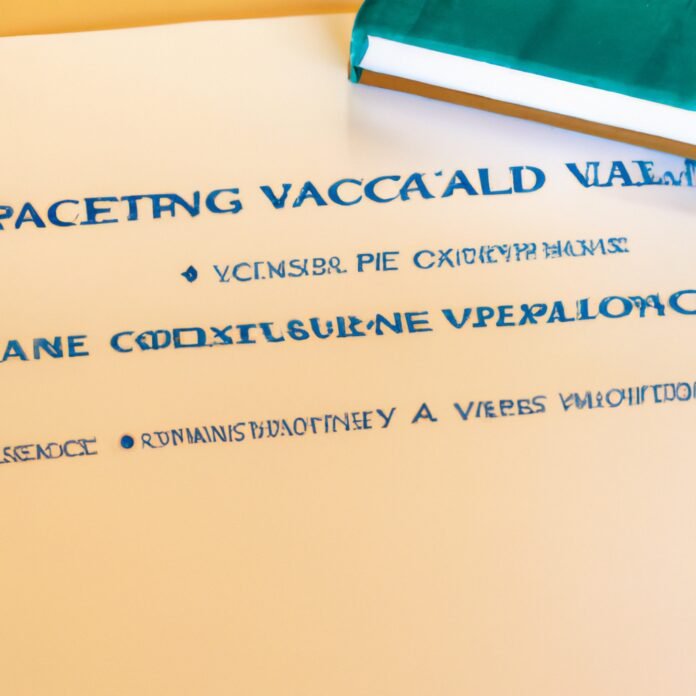Vaccines have been a major weapon in humanity’s fight against disease, from the 1888 discovery of the rabies vaccine to the race to find a vaccine for the novel coronavirus in 2020. But what does it take to make a vaccine? Behind every approved vaccine is a complex journey involving years of research and review – from conception to implementation. In this article, we’ll explore the steps taken in vaccine development, from pre-clinical research to adhering to regulatory standard to ensure its safety and efficacy.
1. A Journey of Vaccine Development: Investigating the Process
Developing and producing a vaccine involves many steps. From analyzing the pathogen, to conducting clinical trials, understanding the approval process, and manufacturing a safe and effective product, the vaccine journey is a complex one.
Scientists begin by identifying the pathogen. This requires the sequence of surface antigens that make the organism identifiable. To do this, advanced genetic analysis is used to decode the genetic material of the virus or bacteria.
Once an effective antigen is identified, a virus is grown in the laboratory and engineering it to include a safe amount of the pathogen’s surface antigens. This engineered virus is then used to create an immunization.
Clinical trials are essential to ensuring the vaccine’s safety and efficacy. These trials are conducted in volunteers from a targeted population, and consist of three or more phases. During these trials, data is collected and analyzed, determining the safety and efficacy of the vaccine.
Once approved, the final step is to manufacture and distribute the vaccine. This entails developing the bins, bottles, and syringes that contain the vaccines, as well as regulating the temperature of the vaccine during transportation and storage. Additionally, there must be efficient communication between government health agencies, healthcare providers, and the public.
2. An Overview of the Research and Development Phase
The research and development phase is a critical part of product development. Here, teams explore different ideas that can be used to create a new product. Professional research and development teams will analyze user needs, survey potential customers, and explore technological solutions to bring the ideas to life.
The research and development phase consists of two key elements: research and development. Research involves conducting experiments and gathering data to analyze a market, develop user needs, and identify technology solutions. During this process, teams use problem-solving strategies to identify optimal solutions and techniques. Development involves using the research to create and design products. Here, teams use concept mapping, prototypes, and simulations to validate a product’s design and performance.
To complete the research and development phase, teams need to:
- Conduct surveys to identify user needs
- Carry out experiments to develop prototypes
- Identify technology solutions and measure performance
- Validate product performance through testing and simulations
By engaging in this process, teams can ensure that a product meets the customer’s needs, is easier to use, and provides a better experience. This work can also lead to faster development time and smaller costs.
3. Lab Trials, Human Trials, and the Regulatory Process
The most important part of bringing a new medicinal product to market is rigorous testing. Every proposed treatment is put through a battery of tests, from lab trials and simulations to human trials, and these must pass certain regulatory standards before the product is approved for public use. Here’s a brief overview of the process:
- Before testing begins, the company must acquire materials and get regulatory approvals.
- Lab trials help to measure the efficacy of a product, and usually involve animal testing.
- Human trials test the product’s effects on trial participants and measure safety and effectiveness.
Clinical trials are multi-phased, from the earliest test studies of a few dozen participants to the larger trials of thousands of people in various stages of the product’s life cycle. Companies are expected to follow ethical guidelines and carefully review safety data throughout the process, as well as study interactions with other medications.
Once trials are complete, the application is reviewed by the relevant regulatory authority. If approved, the product is then released to the public. All new treatments must meet established standards and undergo serious scrutiny before being approved.
4. Testing and Quality Control: Ensuring Safety and Effectiveness
Testing and quality control is essential for any product development process to guarantee both safety and effectiveness. If done properly, it will help you avoid potential legal or liability issues and ensure that your product can be trusted and reaches its intended end user as expected.
This process starts by establishing testing benchmarks and specifications to validate the product against. Once the desired specifications have been set, it is important to establish procedures to ensure that any changes to the product design or materials are documented and then tested to make sure it functions as intended. This may involve various testing methods, such as:
- Performance tests: to check if the product is able to fulfill the intended purpose or does it live up to expectations.
- Compatibility Testing: to ensure that the product is compatible with the rest of the components in the system.
- Safety Testing: to make sure that the product does not cause harm or lead to any accidents when used in a certain environment.
Finally, it is extremely important to implement reviews and assessments of the results to guarantee that the product meets the standards before being released to the public. This includes risk assessment and rating of the product, as well as feedback from testing and user reviews.
5. Approaching Vaccine Authorization: Critical Steps for Approval
Vaccine authorization is essential for the successful launch of any vaccine. It is necessary to ensure that the vaccine has been tested and proven safe and effective for public use. The authorization process should also ensure that the vaccine has been manufactured in a safe manner and is accompanied by the appropriate safety and efficacy documentation.
When it comes to authorizing a vaccine, there are several critical steps that must be taken. These include:
- Conducting Pre-Clinical Testing: The vaccine must be thoroughly tested in animal and cell models, using a wide range of doses and concentrations, to ensure its safety and efficacy. Data from these tests must be documented thoroughly.
- Securing Approval from Regulatory Agencies: The vaccine must be approved by local and international regulatory agencies before it can be authorized for public consumption. This can take several months, as the regulatory agency verifies the safety and efficacy of the vaccine.
- Manufacture the Vaccine According to Safety Protocols: The vaccine must be manufactured to strict standards of quality, safety, and stability. Any deviations from these protocols must be documented carefully.
Approaching vaccine authorization is an exhaustive, highly regulated process. Every basic step must be carefully reviewed and documented in order to secure approval from regulatory agencies. In the end, this process is essential for ensuring the safety and efficacy of the vaccine.
We’ve seen just how involved and complex the process of vaccine development is, from researching to distributing the approved product. With continued progress in science and technology, discovering new ways to stop the spread of deadly diseases is becoming more accessible, offering hope for a healthier future for us all.




